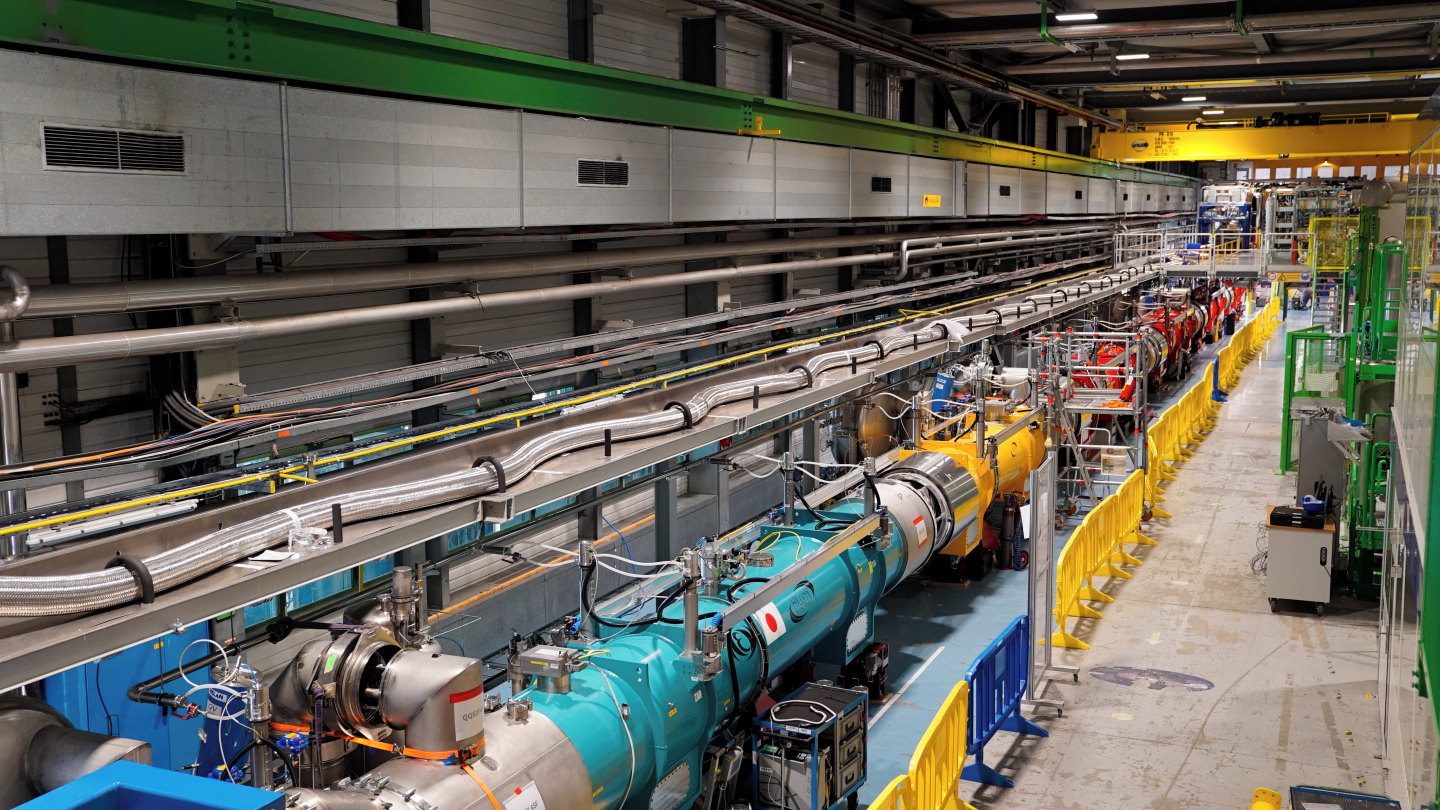
Tous les aimanst et autres éléments du banc d'essai du LHC à haute luminosité sont en place. (Image : Florence Thompson/CERN)
The assembly of the High-Luminosity LHC test stand in CERN's large magnet test hall is entering its final phase, preparing the way for the next-generation LHC. All the components of the test stand are in place and the teams are busy connecting them together.
This 95-metre-long facility is a replica of the new segments that will be installed on either side of the ATLAS and CMS experiments. The High-Luminosity LHC will produce an integrated luminosity ten times greater than that of the LHC, meaning ten times more collisions over the operating period.
More collisions mean denser beams, hence the need for magnets that are capable of generating even higher magnetic fields in order to squeeze the beams more tightly before they meet inside the experiments. The new quadrupole magnets, known as the inner triplets, are made of niobium-tin superconducting coils that allow magnetic fields of up to 11.3 tesla to be generated, as against 8.3 tesla with the LHC's current niobium-titanium inner triplets. This is the first time that such magnets have been used in an accelerator.
The Inner Triplet String test stand, or "IT String", is equipped with six niobium-tin quadrupole magnets grouped together in four cryostats. The set-up also includes corrector magnets and a dipole magnet that is responsible for bringing the beams together in the same tube so that they collide in the heart of the detectors. All these magnets, which were produced at CERN and institutes from the international collaboration, were tested individually before being installed on the test stand.
Weighing between 10 and 18 tonnes, they have been precisely positioned in delicate manoeuvres involving a whole arsenal of handling equipment. They have been integrated into the infrastructure, which was installed last year and is equipped with a cryogenic cooling line that allows them to operate in a conducting state by keeping them at -271°C (1.9 K); it also features a highly innovative power supply line.
"The aim of the test stand is to check how the circuits behave collectively in real conditions", explains Marta Bajko, head of the IT String project. "It will enable us to adjust the procedures for installing the components and for their future commissioning in the LHC during the third long shutdown."

Several teams are working together, sometimes in parallel, to connect and check the multiple power supplies, vacuum insulation systems, cryogenic cooling systems and instrumentation. "This is giving them the opportunity to train and gain experience in a controlled environment before we move into the tunnel," continues Marta Bajko.
The electrical connection of the magnets, which are powered by a cold power-supply system carrying a total current of more than 100,000 amperes, is an example of the complexity of the operations. Connecting the magnets requires around 70 interconnections to be made using a specific brazing technique to ensure the continuity of the superconducting electrical circuits. After a series of checks, the tubes are then welded and the leak tightness of the circuits is verified by vacuum experts.
Other innovations are being tested on the test stand, such as the remote alignment system, which allows the positioning of the magnets to be adjusted with a precision of a tenth of a millimetre along the 95-metre length.
The installation and validation work will continue until the autumn. The line will then start to be cooled to -271°C (1.9 K), using superfluid helium, with the aim of starting to power the magnets by the end of the year.






